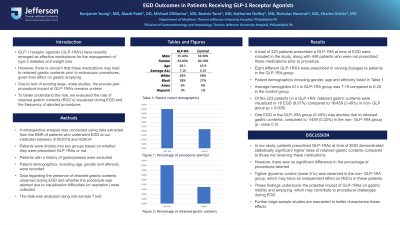Tuesday Poster Session
Category: General Endoscopy
P4097 - EGD Outcomes in Patients Receiving GLP-1 Receptor Agonists
Tuesday, October 29, 2024
10:30 AM - 4:00 PM ET
Location: Exhibit Hall E

Has Audio

Benjamin Young, MD
Thomas Jefferson University Hospital
Philadelphia, PA
Presenting Author(s)
Benjamin Young, MD1, Akash Patel, DO1, Michael J. DiMarino, MD2, Beatriz Torre, MD3, Katherine Duffey, MD1, Nicholas Noverati, MD1, Charles Kistler, MD2
1Thomas Jefferson University Hospital, Philadelphia, PA; 2Sidney Kimmel Medical College at Thomas Jefferson University, Philadelphia, PA; 3Thomas Jefferson University, Philadelphia, PA
Introduction: GLP-1 receptor agonists (GLP-1RAs) have recently emerged as effective medications for the management of type 2 diabetes and weight loss. However, there is concern that these medications may lead to retained gastric contents prior to endoscopic procedures, given their effect on gastric emptying, despite a typical 8 hour fast. Due to lack of existing large-scale studies, the precise peri-procedural impact of GLP-1RAs remains unclear. To better understand this risk, we evaluated the rate of retained gastric contents visualized during EGD and the frequency of aborted procedures.
Methods: A retrospective analysis was conducted using data extracted from the EMR of patients who underwent EGD at our institution between 3/19/2018 and 4/26/24. Patients with a history of gastroparesis were excluded. Patient demographics, including age, gender and ethnicity were recorded. Data regarding the presence of retained gastric contents observed during EGD and whether the procedure was aborted due to visualization difficulties (or aspiration) were collected. The data was analyzed using one sample T test.
Results: A total of 223 patients prescribed a GLP-1RA at time of EGD were included in the study, along with 449 patients who were not prescribed these medications prior to procedure. In both cohorts, the majority of patients were female (64.6% of patients in the GLP-1RA group, 66.1% in the control group) and White (62% of patients in the GLP-1RA group, 66% in the control group) (Table 1). Of the 223 patients on a GLP-1RA, retained gastric contents were visualized in 18 EGD (8.07%) compared to 16/459 (3.49%) in non- GLP group (p = 0.005). One EGD in the GLP-1RA group (0.45%) was aborted due to retained gastric contents, compared to 1/459 (0.22%) in the non-GLP-1RA group (p-value 0.3).
Discussion: In our study, patients prescribed GLP-1RAs at time of EGD demonstrated statistically significant higher rates of retained gastric contents compared to those not receiving these medications. However, there was no significant difference in the percentage of procedures aborted. These findings underscore the potential impact of GLP-1RAs on gastric motility and emptying, which may contribute to procedural challenges during EGD. Further prospective studies with additional patients are warranted to better characterize these effects.
Note: The table for this abstract can be viewed in the ePoster Gallery section of the ACG 2024 ePoster Site or in The American Journal of Gastroenterology's abstract supplement issue, both of which will be available starting October 27, 2024.
Disclosures:
Benjamin Young, MD1, Akash Patel, DO1, Michael J. DiMarino, MD2, Beatriz Torre, MD3, Katherine Duffey, MD1, Nicholas Noverati, MD1, Charles Kistler, MD2. P4097 - EGD Outcomes in Patients Receiving GLP-1 Receptor Agonists, ACG 2024 Annual Scientific Meeting Abstracts. Philadelphia, PA: American College of Gastroenterology.
1Thomas Jefferson University Hospital, Philadelphia, PA; 2Sidney Kimmel Medical College at Thomas Jefferson University, Philadelphia, PA; 3Thomas Jefferson University, Philadelphia, PA
Introduction: GLP-1 receptor agonists (GLP-1RAs) have recently emerged as effective medications for the management of type 2 diabetes and weight loss. However, there is concern that these medications may lead to retained gastric contents prior to endoscopic procedures, given their effect on gastric emptying, despite a typical 8 hour fast. Due to lack of existing large-scale studies, the precise peri-procedural impact of GLP-1RAs remains unclear. To better understand this risk, we evaluated the rate of retained gastric contents visualized during EGD and the frequency of aborted procedures.
Methods: A retrospective analysis was conducted using data extracted from the EMR of patients who underwent EGD at our institution between 3/19/2018 and 4/26/24. Patients with a history of gastroparesis were excluded. Patient demographics, including age, gender and ethnicity were recorded. Data regarding the presence of retained gastric contents observed during EGD and whether the procedure was aborted due to visualization difficulties (or aspiration) were collected. The data was analyzed using one sample T test.
Results: A total of 223 patients prescribed a GLP-1RA at time of EGD were included in the study, along with 449 patients who were not prescribed these medications prior to procedure. In both cohorts, the majority of patients were female (64.6% of patients in the GLP-1RA group, 66.1% in the control group) and White (62% of patients in the GLP-1RA group, 66% in the control group) (Table 1). Of the 223 patients on a GLP-1RA, retained gastric contents were visualized in 18 EGD (8.07%) compared to 16/459 (3.49%) in non- GLP group (p = 0.005). One EGD in the GLP-1RA group (0.45%) was aborted due to retained gastric contents, compared to 1/459 (0.22%) in the non-GLP-1RA group (p-value 0.3).
Discussion: In our study, patients prescribed GLP-1RAs at time of EGD demonstrated statistically significant higher rates of retained gastric contents compared to those not receiving these medications. However, there was no significant difference in the percentage of procedures aborted. These findings underscore the potential impact of GLP-1RAs on gastric motility and emptying, which may contribute to procedural challenges during EGD. Further prospective studies with additional patients are warranted to better characterize these effects.
Note: The table for this abstract can be viewed in the ePoster Gallery section of the ACG 2024 ePoster Site or in The American Journal of Gastroenterology's abstract supplement issue, both of which will be available starting October 27, 2024.
Disclosures:
Benjamin Young indicated no relevant financial relationships.
Akash Patel indicated no relevant financial relationships.
Michael DiMarino indicated no relevant financial relationships.
Beatriz Torre indicated no relevant financial relationships.
Katherine Duffey indicated no relevant financial relationships.
Nicholas Noverati indicated no relevant financial relationships.
Charles Kistler indicated no relevant financial relationships.
Benjamin Young, MD1, Akash Patel, DO1, Michael J. DiMarino, MD2, Beatriz Torre, MD3, Katherine Duffey, MD1, Nicholas Noverati, MD1, Charles Kistler, MD2. P4097 - EGD Outcomes in Patients Receiving GLP-1 Receptor Agonists, ACG 2024 Annual Scientific Meeting Abstracts. Philadelphia, PA: American College of Gastroenterology.
